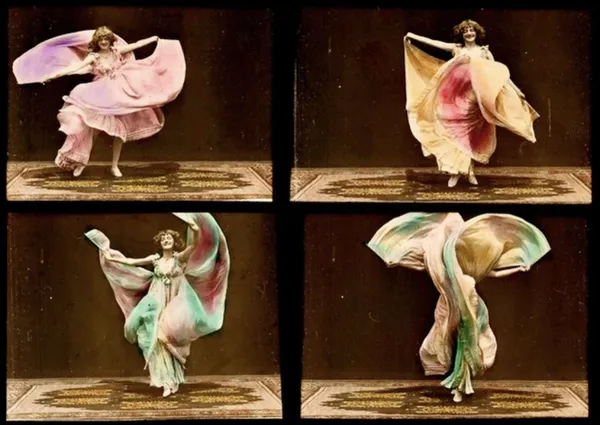 |
| Marcel Dzama on Loïe Fuller in Sabine Krayenbühl and Zeva Oelbaum’s Obsessed With Light: ”She really was the beginning of the past looking to the future.” |
Sabine Krayenbühl and Zeva Oelbaum’s visually illuminating Obsessed With Light (a DOC NYC highlight) has an impressive list of on-camera interviews, which include Robert Wilson on what came first for Einstein on the Beach; Dior Creative Director Maria Grazia Chiuri; designer Iris van Herpen (Architectonics); theatrical lighting designer Jennifer Tipton; choreographers Moses Pendleton (MOMIX), Ola Maciejewska, Bill T Jones, Trajal Harrell and Maite Marcos (Shakira); artists William Kentridge, Elín Hansdóttir, and Marcel Dzama; Drift collective founders Lonneke Gordijn and Ralph Nauta; puppeteer Basil Twist on Titan et L’Aurore, and theatre producer Jordan Roth all sharing their insights on the significant impact Loïe Fuller’s creativity and innovation has had on them and their work.
Cherry Jones, as the voice of Fuller, is our guide throughout Obsessed With Light and Loïe’s influence is in the air of New York City. From Ola Maciejewska’s Bombyx Mori at the French Institute Alliance Française to Trajal Harrell’s The Köln Concert (performed by the Schauspielhaus Zürich Dance Ensemble with music by Joni Mitchell and Keith Jarrett) at BAM this past week, plus Marcel Dzama’s permanent mosaic in the MTA subway (at the Bedford Avenue station on the L line) and Drift’s aerial performances over the Central Park lake last month - Fuller’s legacy lives on.
From New York City, Sabine Krayenbühl and Zeva Oelbaum joined me on Zoom for an in-depth conversation on Obsessed With Light and Loïe Fuller.
Anne-Katrin Titze: Hi! How are you both!
Sabine Krayenbühl: We’re fine! As you can see we are in a very “tech” office between monitors and other things.
AKT: You have a very impressive group of people talking about Loïe Fuller! Let’s start with Robert Wilson! Iris van Herpen! I didn’t expect or Maria Grazia Chiuri! Tell me how you assembled all these people!
Zeva Oelbaum: You know, the thing that really quite amazed us when we decided to do the film on Loïe Fuller, was when we were researching online and people’s names started popping up. We just kept going down the different roads and getting leads and researching, like a spiderweb, like we did with Letters from Bagdad. The depth of her influence and the breath of her influence was just so surprising to us every day.
SK: Sometimes we came across these connections because it said Loïe Fuller and someone. But we also researched artists that were concerned with the same themes that she was and that was one of the reasons for Robert Wilson. We weren’t sure that he had a connection, but then it turns out when we actually talked to him, he knew exactly who she was and he immediately said how she was so influential also for him.
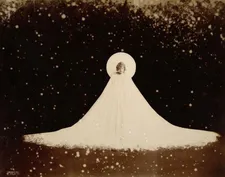 |
| Sabine Krayenbühl on Loïe Fuller in Obsessed With Light: “As you know from Letters from Baghdad, we searched high and low for clips of Loïe, as we did with Gertrude Bell.” |
AKT: Before we hear Wilson talk, there is a clip with Isabelle Huppert, I believe, from one of his performances. And then he says something really interesting: “Light is what helps you to hear and to see better.” To include hearing with light, is very interesting!
SK: I think light is, as some of the artists also talk about, an emotional experience. It goes deeper than just the visual experience. It’s also a feeling. I think Jennifer Tipton talks a little bit about the mystery. We don’t really know what it is about light.
ZO: As we were interviewing people, of course we started with the idea of what their connection with Loïe Fuller was, but it turned out that so many of the artists talked about their relationship to light specifically, so that we realised that that was another really important avenue for us to question them about. We really loved that sort of synergy between Loïe Fuller’s fundamental interest in light and all these other artists’ interest in light.
AKT: I believe you even have an interview with the artists who did the light installation over Central Park last week! [Interrupting the bird migration - I should add in brackets.] Did you know about this event when you interviewed them for your film?
SK: No, it is so funny because it happens that right now when our film is coming out, four of our artists have all converged upon New York. There is Ola Maciejewska, the Polish dancer, she has a performance this week at FI:AF. Trajal Harrell is having a performance at BAM, Marcel Dzama is doing another performance next week and obviously he is in the New York Subway. And then Drift was just here. It’s almost like Loïe is in the air!
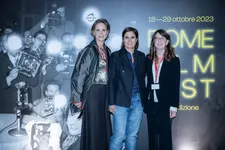 |
| Sabine Krayenbühl and Zeva Oelbaum with Dior Creative Director Maria Grazia Chiuri at the Rome Film Festival Obsessed With Light World Premiere |
AKT: The clips you show from Ola’s work are terrific! The Rorschach test, inkblot visuals, and the idea that the body with this costume turns into a hybrid, a cyborg almost, are all fascinating to ponder. How did you connect with her?
SK: Trajal had worked with her in Chicago on a piece. As you know from the film, he’s looking at it in terms of history and research, the historical aspect of her and her surroundings. And Ola was invited, I think it was at The Art Institute of Chicago. And he said “You’ve got to talk to Ola.”
AKT: It is one of the most impressive moments, because you realise where dance is going in the present. I want to go a bit into the history and the Paris Exposition of 1900. You show “The Moving Sidewalk” and some other attractions, besides Loïe Fuller’s contribution. This could make an entire documentary on its own.
ZO: I think there has been, probably. It was an incredible event.
SK: It’s in a way the place where all of Loïe’s things come together - technology, art, science. And she is at this very important intersection - she has her own theatre! As a woman! It places her not just in terms of what’s going on but also in terms of her notoriety and her importance.
AKT: Starting out as a “Western Gal,” as she herself says, in the voice of Cherry Jones! It reminded me, actually, of Patricia Highsmith, who in a documentary on her, is shown as a little girl, dressed in a Western outfit, and referred to as something like “Western Gal.”
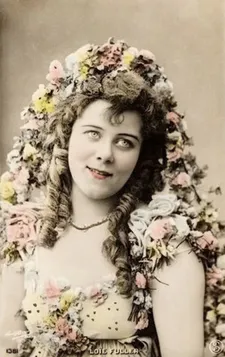 |
| Zeva Oelbaum: “The sensitivity that fashion should have to people who are not model-thin. It’s very powerful in context with Loïe Fuller.” |
ZO: Really?
AKT: Yes, and both of them, we wouldn’t associate with “Western Gal” at all.
SK: I remember we once came across a reference in COWGIRL magazine.
AKT: The Nautch girl dress started it all. We hear that she got it from Calcutta and it is a piece of clothing in itself inspired by Dervishes - tell me more about that garment! It will lead us into the discussion of the great designers you have in the film.
ZO: Loïe Fuller had a lot of different versions of the beginning of her origin story of the Serpentine Dance. One of the ones that we found most wonderful, that she repeated most often, was that she was given this beautiful silk skirt by soldiers that she had sat next to on a train and she put it on and it was in her trunk and she was looking for a costume for a performance but had no money. She found the skirt, but it was too long so she held it up and twirled around in the one section of the performance where she was supposed to be hypnotised. She was sort of an opportunist and able to take things and incorporate them into her work. She was really a genius at that.
AKT: You are very good at that, too, both of you, with all the fine details you include in the frame. For example the toddler on the balloon. We wonder, is this her? Probably not, because you would have made a big deal out of that. Another one is where we see a dog in her costume! And yet another, about the “dance without feet.” All of this is for our amusement in addition and gives even more colour to the main story!
SK: As you know from our background, we love archival footage. When we go on this treasure hunt, we come across all kinds of things, you can imagine on the editing floor we have so many fantastic clips. The idea is to bring people in and visually relate. It’s not exactly you see what you get, what you hear, it’s really about creating an atmosphere and a sense of Loïe. I mean we have these two clips, and in only one you can really see her.
 |
| Ola Maciejewska at the post-performance Q&A of her Loïe Fuller inspired Bombyx Mori at the French Institute Alliance Française in New York Photo: Anne-Katrin Titze |
Once again, as you know from Letters From Baghdad, we searched high and low for clips of Loïe, as we did with Gertrude Bell. It’s the idea of creating with the existing footage, also because Loïe Fuller’s Serpentine Dance is part of cinema history. It’s part of the first films there were. In fact her Serpentine Dance, the one that is performed by Annabelle Moore, the Edison clip, is considered the first hand-tinted clip there is. It’s the idea of placing her and creating an atmosphere and her character with the existing clips there are.
AKT: It’s great to hear Maria Grazia Chiuri, Creative Director of Dior, speak, connecting to Loïe Fuller. She herself is a great force in fashion.
ZO: We came across her online, that her Spring/Summer 2019 collection, I think, was influenced by the early dance pioneers. We were able to find a connection to her, which was fantastic. She was amazing, as you saw in the interview. And we just did our world premiere in Rome and she attended the screening. We have photographs with her and it was very exciting.
SK: But we’ll have to find out what she thought of the film.
ZO: We felt her interview was so valuable because she speaks really beautifully and articulately about women’s views of themselves, and body image and fashion. The sensitivity that fashion should have to people who are not model-thin. It’s very powerful in context with Loïe Fuller.
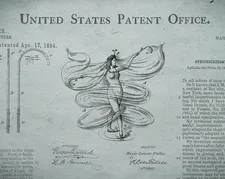 |
| Marie Louise (aka Loïe) Fuller's US Patent April 17, 1894 |
AKT: Iris Van Herpen, her clothes, well, garments, artworks, I saw her work for the first time at the Met’s Costume Institute and spoke with Andrew Bolton about it. He often has pieces by her included. She speaks in your film about making mistakes as her favourite part of the creative process.
SK: We found out about her because of Jordan Roth who worked with her on his costume that he paraded at the Met Gala. That’s how we found out about Iris Van Herpen. It’s interesting that every person that’s interviewed talks also about the creative process. And when we talked to her she confirmed that she knew about Loïe Fuller and had a background as a dancer. She talks about the experimentation and the collaboration between her and scientists, between the arts and other disciplines and the fact that she goes through these mistakes. Loïe was a relentless experimenter who was constantly trying to perfect her art, her performance and it had to be through trial and error. And that’s the process of so many artists.
AKT: It’s good to have these contemporary voices because when Loïe Fuller was alive there were all these artists around her. Toulouse-Lautrec made paintings of her, Jean Cocteau saw her perform, of course her connection with Auguste Rodin - I saw you give thanks to the Rodin Museum in the end credits. At the very end we even see a building façade by Pierre Roche with a caryatid inspired by Fuller! It all accomplishes a beautiful mirroring of the then and the now.
ZO: What we thought would make the film resonate would be not just to highlight the incredible accomplishments of Loïe Fuller, although she was obviously an amazing visionary trailblazer. But the fact that even if people don’t know her name, which is most people, that her work is all around us. And that’s the thing we felt was most noteworthy and interesting and newsworthy about her.
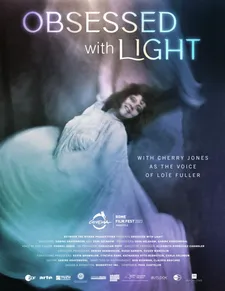 |
| Obsessed With Light poster |
SK: The other thing is also, a theme that goes through the film in many different ways, is the idea of the imitators and the influence. As in, where does your influence come from? What have you seen? How does that come out in some new form? In a way some of the contemporary people are imitators or influenced - so this discourse about how do you create art and where does it come from and how do you process it, was very important for Loïe, but is also important for these contemporary artists.
AKT: The idea of the body, that is so central, we touched on it before, that Loïe Fuller created a dance without the body, but the movement is there. The idea of the cyborg, the hybrid body, the disappearing body, I think is not only a question for the past and the present but will be even more so for the future.
SK: Yes, Marcel Dzama says it beautifully in his quote: “”She really was the beginning of the past looking to the future.”
AKT: Thank you so much for this conversation!
ZO: Thank you! We’re thrilled!
SK: Thank you!
DOC NYC Obsessed With Light screenings will take place on Saturday, November 11 at 3:15pm - IFC Center and on Sunday, November 12 at 11:00am - Village East by Angelika. Sabine Krayenbühl and Zeva Oelbaum will participate in post-screening Q&As following both screenings. Obsessed With Light will be available online from Sunday, November 12 through Sunday, November 26.
DOC NYC in-cinema screenings run from Wednesday, November 8 through Thursday, November 16.






















